Alucard
Harmless

Posts: 22
Registered: 6-2-2019
Location: European Union
Member Is Offline
|
|
Selective reduction of nitrotoluenes with Na2S
I've read all the forum topics available prior to reduction of NT's but nothing was found related to topic.
So I've read somewhere that it's possible to selectively reduce para isomer from a mix of ortho and para nitroluenes by treating it with a basic
solution of Na2S at 20C or room temperature, thus yelding a ortho nitrotoluene and para toluidine.
At first I prepared a Na2S solution, by treating 8g or sulfur with 20g of NaOH without boiling this mixture, so it must be a sodium polysulphide and
sodium sulphite solution as well. I've got a dark orange-red solution, so a whole reaction went OK, and then filtered out from unreacted sulphur.
Secondly, I took a 39g of the NTs mixture, and a temperature of it's was about 0C, cause I'm storing chemicals in the shed outdoors, so it's cold
inside of shed. To this mixture I then added a freshly prepared solution of sodium sulphide and sodium sulphite, which was warm a bit by it's own, say
about 30C or 40C and whole mixture of all reagents became about 15C warm. Then this mixture was vigorously stirred within 20 minutes.
As result of all of this I've got a 2 layers of liquid, the upper layer was ortho nitrotoluene (I think so) and the bottom layer was a dark orange-red
solution of my reduction reagent. I've noticed that layer of the ortho nitrotoluene became a clear, non-turbid and yellow liquid, but before the
reaction it was of course yellow, but a cloudy, non-transparent and turbid liquid, as it was during the washing steps while preparing NT's from
toluene.
As nothing was precipitated out, I decided to let all the reaction mixture to sit for a nigth at temperature about from -2 up to 0 or +2C
appoximately. At the morning next day I've stirred this mixture for a five minutes, after turning off the stirrer I've got a light brown color bottom
layer of Na2S and sodium sulphite, with a lot of yellow droplets inside this layer, and the upper layer was obtained at very slow rate, because the
droplets of organic layer were unable to unite into one big layer, but after shaking gently I was able to separate organic layer from the reaction
mixture. A three separations were made, because some organic droplets went along with sulphide/sulphite layer.
After organic layer was fully separated it was threated with 37% HCl, so yelding two layers again, and bottom acidic layer was transparent and
discolored, but upper yellow organic layer become cloudy again.
A acidic layer was separated and threated with Ca(OH)2, but remaining acid or as I suspect toluidine hydrochloride was treated with Na2CO3, thus there
was no remaining unreacted Ca(OH)2 in the mix. After doing this, no more layers appeared, but a whole liquid turned slightly yellow and cloudy, with
no any precipitate.
Keeping in mind I have no benzene or diethyl ester for extraction, I decided to take a two small samples from gained para toluidine (if it's it) and
mix one sample with acetone, and other with toluene. A toluene was not able to extract anything, and stood as clear and transparent upper layer. An
acetone was mixed with toluidine and all the solution turned transparent and no longer any yellowish, but cloudy, besides a sample treated with
toluene, was unchanged and slightly yellow cloudy. Then to the acetone sample I've added a bit of toluene, to see will any transition from layer to
layer happen or not. Nothing happened, and I decided to let both two samples sit overnight.
Next day, a second sample, consisting from acetone, toluene and toluidine become clear and transparent (all two layers). Then I've mixed both samples
together and a toluene layer was discarded. After doing this, I decided to salt out the acetone, thus adding NaCl to remaining acetone and toluidine
mixture. When no more salt dissolving, a salted out liquid was moved from a beaker to the dish, what caused a lot of white non-transparent flakes to
precipitate.
Treating these flakes with 60-65% H2SO4 caused no gas evolution, and mixture turned yellow. Adding a solution of K2Cr2O7 to this mixture caused some
precipitation of very small, non-transparent crystalls.
A whole solution of toluidine (or what these flakes are), H2SO4 and K2Cr2O7 looks like this, the right one (left one is a solution of K2Cr2O7) :
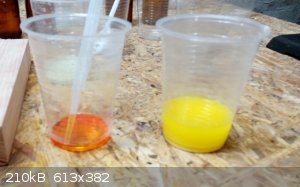
So, I do not think that these flakes were simply a NaCl, in case that acetone was not salted out completely, and contained water with large excess of
NaCl in that water.
As another experiment, I tried to take organic layer, separated from the beginning, e.g. from a mix of initial nitrotoluenes and reduction reagent, so
it must be an ortho nitrotoluene. A sample of this o-nitrotoluene was mixed with acetone, with no changes in color occured, and then salted out,
obtaining a transparent slightly yellow liquid :
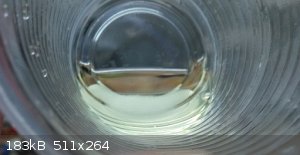
Because I had a residue of so called toluidine, I tried to make another experiment, so - to precipitate more flakes from a toluidine mixture. So I
have added some acetone, salted it out, and then released this acetone-toluidine mixture to the dish, and nothing happened, so it was not possible to
repeat experiment like I did with the sample which stood overnight (e.g. acetone, toluol and toluidine mixture). I can note that at time freshly
prepared solution of toluidine and acetone looked milky, so maybe it is really required to let this mixture sit for a few hours or a whole night to
fully complete a transition of toluidine from the water to the acetone, and then salt acetone out.
So I would like to ask a following :
I do not believe that these precipitated flakes are toluidine, because p-toluidine must be transparent crystalls, but not this damn thing I've got.
Are these flakes simply p-nitrotoluene? How to check what is this, without isolating and melting these crystalls, is there any analytical chemical
reaction to discover toluidine or nitrotoluene in the mix?
Another big question is why there was no success in repeating to precipitate these flakes.
So, any suggestions?
|
|
|
zed
International Hazard
    
Posts: 2277
Registered: 6-9-2008
Location: Great State of Jefferson, City of Portland
Member Is Offline
Mood: Semi-repentant Sith Lord
|
|
Seems to me, Toluidine and Acetone might be incompatible. Forming an imine.
Use another solvent.
I would also keep in mind, that Anilines are toxic. Some, more-so than others
|
|
|
Boffis
International Hazard
    
Posts: 1836
Registered: 1-5-2011
Member Is Offline
Mood: No Mood
|
|
This is called the Zinin reaction and a review of this reactions has been posted at least twice before. It was written by H Porter and I suggest you
read it before carrying out any more experiments. Pay particular attention to the bottom of page 458-top of 459 and page 464.
Basic points:-
A) The reaction is best carried out in aqueous ethanol or methanol
B) Both o and p nitrotoluenes are reduced, though when more than one nitro group is present the less sterically hindered group is reduced
preferentially. When only one is present on each molecule I suspect that the less sterically hindered nitro group will be reduced more quickly,
however, I could not see this implicitly stated.
C) The products are not the same, o-nitrotoluene give o-toluidine where as p-nitrotoluene can give up to 75% of p-aminobenzaldehyde with some
p-toluidine.
My conclusion would therefore be that with careful control of condition and ratios it should be possible to preferentially reduce the p-nitro isomer
but the product may not be simple p-toluidine. You may not have obtained any reduction product at all in your experiment due to the lack of contact
between the aqueous reductant and the organic phase; this is why most published procedures use aqueous methanol.
I presume that your test with dichromate was to see if you get a dark oxidation product as a test for toluidines?
Finally, what is the goal of your experiment? Is it to isolate o-nitrotoluene or p-toluidine or some other objective?
Given the difficulty in separating o and p-nitrotoluene completely for most amateurs and that usually toluidines are their target this could be a
useful piece of research. So read and please keep us informed!
Attachment: Zinin sulphide reduction of nitroarenes Book Chp 4 H K Porter no date.pdf (777kB)
This file has been downloaded 288 times
|
|
|
Alucard
Harmless

Posts: 22
Registered: 6-2-2019
Location: European Union
Member Is Offline
|
|
Quote: Originally posted by zed  | Seems to me, Toluidine and Acetone might be incompatible. Forming an imine.
Use another solvent.
I would also keep in mind, that Anilines are toxic. Some, more-so than others |
I will try to research about possible reaction between acetone and toluidine. Anyway acetone is not appropriate extragent for this case, a better
policy would be to make some diethyl ether, but I have to buy an adapter for a termometer? I have a plastic cork 19/26 but not sure if it would be a
good idea to make tight hole in that cork and setup termometer through it, who knows maybe this plastic cork will melt while reaction will occur, as
well as it will have to be processed at 140-145C for classical diethyl ether route.
Quote: Originally posted by Boffis  |
Basic points:-
A) The reaction is best carried out in aqueous ethanol or methanol
B) Both o and p nitrotoluenes are reduced, though when more than one nitro group is present the less sterically hindered group is reduced
preferentially. When only one is present on each molecule I suspect that the less sterically hindered nitro group will be reduced more quickly,
however, I could not see this implicitly stated.
C) The products are not the same, o-nitrotoluene give o-toluidine where as p-nitrotoluene can give up to 75% of p-aminobenzaldehyde with some
p-toluidine.
|
My reference actually says the folliwing -
"Pure o-nitrotoluene (with traces of m-nitrotoluene) might be isolated from a mixture of nitrotoluenes by reducing it by basic reducing agent (for
example Na2S) under the room temperature conditions, what leads to only redox of p-nitrotoluene to p-toluidine, which might be easily isolated using
it's general properties."
This reference even does not says that it's obligated to use exactly Na2S, it only suggests it. As well as I have not only sulphide, but sulphite too,
it's not known does sulphite interfere in the redox reaction, if this reaction even happened under my conditions. Also no any solvent is mentioned,
but I actually think there must be a solvent, like ethanol, but not 100% sure about this.
Quote: Originally posted by Boffis  |
My conclusion would therefore be that with careful control of condition and ratios it should be possible to preferentially reduce the p-nitro isomer
but the product may not be simple p-toluidine. You may not have obtained any reduction product at all in your experiment due to the lack of contact
between the aqueous reductant and the organic phase; this is why most published procedures use aqueous methanol.
|
I think no redox occured at all, because I left a reaction mixture with no stirring, it was stirred about 20 minutes at all, who knows how long
reaction must occur, keeping in mind that only part of mix of the nitrotoluenes must be reduced, it is not possible to detect if a whole reaction is
completed by simply smelling odour of the whole mix.
Quote: Originally posted by Boffis  |
I presume that your test with dichromate was to see if you get a dark oxidation product as a test for toluidines?
|
Exactly so, but I ran out of ammonia. Anyway, adding all ammonia solution I had gave nothing at all, no reaction occured, no blue colouring observed.
Quote: Originally posted by Boffis  |
Finally, what is the goal of your experiment? Is it to isolate o-nitrotoluene or p-toluidine or some other objective?
|
I need only ortho-nitrobenzoic acid actually, but I'm looking forward to p-cresol as well.
Quote: Originally posted by Boffis  |
Given the difficulty in separating o and p-nitrotoluene completely for most amateurs and that usually toluidines are their target this could be a
useful piece of research. So read and please keep us informed!
|
Ok, but under my conditions a better policy might be a complete oxidation of the whole mixture of nitrotoluenes with K2Cr2O7, which is available to
me, and then separating nitrobenzoic acids by acetone, I have read that ortho-nitrobenzoic acid is highly soluble in acetone, but para isomer ain't.
Yet another approach might be to add water to the mix of the nitrotoluenes and perform a direct steam distillation to try to obtain a new mix of the
nitrotoluenes, but with different % ratios, say not approximately 65/35 % of ortho/para, but another ratio, but it will require to distill not all the
nitrotoluenes with water, but say a half of the nitrotoluene mixture. It will only work if for example para or ortho isomer is more volatile than
another isomer, so who knows what exactly will occur while trying to steam distill a part of the nitrotoluene mixture.
I think I will try to perform such steam distillation, it will also at least remove a remaining toluene if it is present in the mix. I think it might
be an option to measure a density of initial mix, and a density of the forerun of the distillation process and compare this density data. Some sources
say that para isomer is more volatile with water, so if para will be predominant, it likely will solidify out under much moderate conditions, say at
temperature above 0C, who knows. For example if there would be a new mixture, say 80% of para and 20% ortho isomers, it will help to make a freezing
out process of para isomer much easier.
|
|
|
nitro-genes
International Hazard
    
Posts: 1048
Registered: 5-4-2005
Member Is Offline
|
|
Do you have the reference for selective reduction of paranitrotoluene using sulfides? Only knew that 2,4-dinitrotoluene behaves somewhat peculiar
towards reduction, in that surprisingly, the para nitro group is preferentially reduced by sodium sulfide, whereas acidic conditions (98%Ethanol/dry
HCl, steelwool @ <30 deg C) produces mainly 2-amino 4-nitrotoluene (also see: https://doi.org/10.1111/j.1478-4408.1946.tb02402.x). If this indeed also works for the mononitrotoluenes it could be a nice way to separate the
o-nitrotoluene isomer.
Also have a reference for the difference in acetone solubility for the benzoic acids? IIRC, I only noticed some patent separating the methylesters of
these by fractional distilation, obviously acetone solubility would be much easier, nice! 
[Edited on 9-2-2019 by nitro-genes]
|
|
|
Alucard
Harmless

Posts: 22
Registered: 6-2-2019
Location: European Union
Member Is Offline
|
|
Quote: Originally posted by nitro-genes  | Do you have the reference for selective reduction of paranitrotoluene using sulfides?
[Edited on 9-2-2019 by nitro-genes] |
No, all I've is this sencence from a chemical written in Russian, I already translated all info, it says exactly -
"Pure o-nitrotoluene (with traces of m-nitrotoluene) might be isolated from a mixture of nitrotoluenes by reducing it by basic reducing agent (for
example Na2S) under the room temperature conditions, what leads to only redox of p-nitrotoluene to p-toluidine, which might be easily isolated using
it's general properties."
Absolutely no more data about this method.
Almost the same conditions are preferred to make p-aminobenzaldehyde, a method above only differs it is processed with no any any reflux and no
solvent mentioned.
Quote: Originally posted by nitro-genes  |
Also have a reference for the difference in acetone solubility for the benzoic acids? IIRC, I only noticed some patent separating the methylesters of
these by fractional distilation, obviously acetone solubility would be much easier, nice! 
[Edited on 9-2-2019 by nitro-genes] |
Yes, it's possible.
o-nitrobenzoic acid :
Solubility (g/100 g of solvent):
acetone: 93.1 (30°C) [Ref.]
methanol: 53.4 (10°C) [Ref.]
p-nitrobenzoic acid :
Solubility (g/100 g of solvent):
acetone: 5.75 (10°C) [Ref.]
methanol: 12 (10°C) [Ref.]
In english language this info is available here :
http://chemister.ru/Database/properties-en.php?dbid=1&id=5102
http://chemister.ru/Database/properties-en.php?dbid=1&id=4758
Method which involves a fractional distillation of methyl esters of nitrobenzoic acid claims to yeld a pure nitrobenzoic acids, what as I think might
be very difficult to do using a fractional crystallization of these acids in any solvent possible, even acetone. Some traces of impurity may still
appear after recrystallization is done.
********
Today I tried to test the following :
1. Salt out nitrotoluenes from water with NaCl
2. Directly steam distill nitrotoluenes
The first experiment seemed to be successfull, after table salt addition a whole amount of liquid became no longer cloudy.
A salt is seen at the bottom of the beaker :
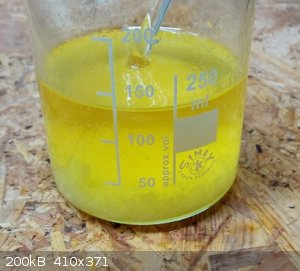
A weight of a 10 ml of a drained liquid is 10,47 gr.
Note it's remaining nitrotoluenes, untouched with reduction attempt.
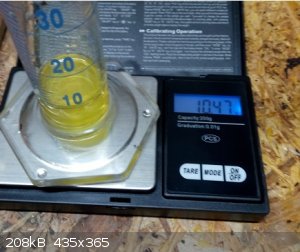
Same nitrotoluenes drained ffrom salt
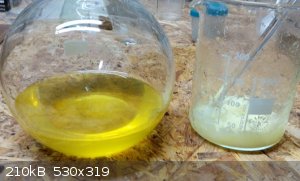
Water added before steam distillation, a 50/50 proportion.
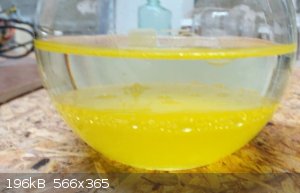
The table salt residue was dissolved in water, small amount of nitrotoluenes was contaminated with salt.
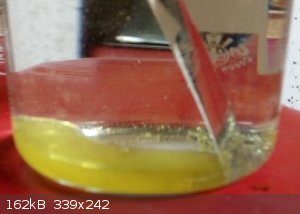
After standing for a while, a table salt residue, which was left after salting out initial nitrotoluene mix gave a thin and transparent top layer, it
might be a toluene. A water is a middle layer, and nitrotoluenes are the bottom one.
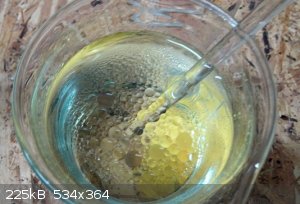
The forerun of the steam distillation :
A two layers are visible, the bottom one is milky a bit. It must be almost all the water. The top layer has very hard smell of toluene.
It's clear absolutely that water and toluene are azeotropic with ortho-nitrotoluene at least. A three or more component azeotrope forms, coming out at
92C approx. About half of it is a water.
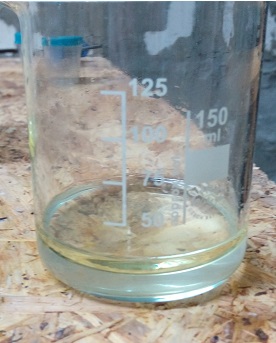
After all the toluene is now consumed a water is coming out, probably slightly contaminated with para isomer, it happens at 96-98C
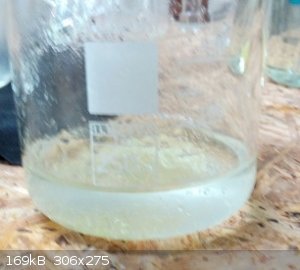
A steam distillation in a aborted, a residue remained in a distillation flask is now washed.
A small success is that there is no toluene present right now.
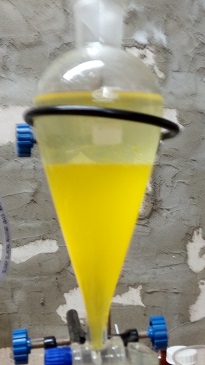
Besides a previous redox attempt :
I have found a pasteur pipette, which was used to gain these white flakes, solidified from acetone. All the flakes readily dissolved in a small amount
hot water during the washing of the pipette. This means that these ones were simply a table salt, contaminated in a small batch of a water,
transferred along with acetone, due to that fact that it seems that salting out of the acetone was not fully completed. Releasing that sample of
acetone to a large area, yielded a fast precipitation from possibly oversaturated solution of the salt in water, transferred along with acetone.
So I can claim that redox experiment was failed.
Almost the same conditions are mentioned to obtain a p-aminobenzaldehyde. Thus, doing a reflux of nitrotoluenes with Na2S highly likely will yield a
p-aminobenzaldehyde. Running this experiment with no stirring at low temperatures within interval from -2 to +2 C, with no solvent used gave
completely nothing, or too small batch, which cannot be identified by it's smell or somehow like that.
|
|
|
Alucard
Harmless

Posts: 22
Registered: 6-2-2019
Location: European Union
Member Is Offline
|
|
Today I tried to repeat a Na2S reduction, but with a couple of changes of this process.
To make a redox agent more basic, a 8g of sulphur were reacted with 25g NaOH. No heating were applied to these reaction mix, but it was filteres from
unreacted sulphur.
Then, a 35g of mixed nitrotoluenes were added to this redox agent, e.g. a mixture of Na2S and Na2SO3. After that, a two teaspoons of Na2CO3 were added
to a mixture obtained above. Although exact mass of Na2CO3 was not measured, one may consider it's about from 5 to 10 gram.
Reaction mass was vigorously stirred for a one hour, and a temperature about +20C was kept.
After stopping a stirrer, two layers were obtained. Now, organic layer is a bottom layer. Within a previous Na2S experiment, organic layer was a top
layer.
Bottom layer contains no solids, it's simply a big amount of a yellow droplets of organic liquid, unable to unite.
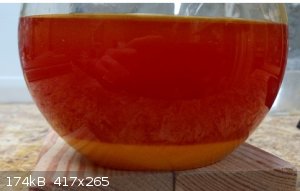
Drained off Na2S layer
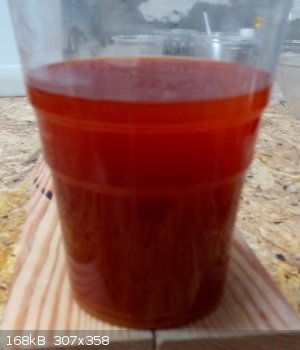
Being decanted, bottom layer is starting to unite from a large amount of a small droplets into big one droplet.
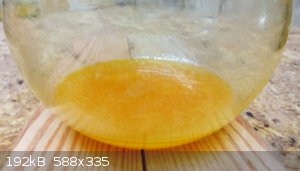
All the reaction liquids, both organic and unorganic were mixed back again togetner. I left a whole reaction mass to sit for a night or maybe longer.
Still have no idea, why this case organic layer is a bottom layer, not a top one. Not sure about it, but maybe all of nitrotoluenes were reduced.
I think a best option would be to try to steam distill a whole mixture, because all toluidines are steam volatile.
Anyway, I'm starting thinking that a better approach is to oxidize a nitrotoluene mix to appropriate mix of nitrobenzoic acid, metilate it with say
sodium methyl sulphate and then fractionally distill the esters and then hydrolize with NaOH, thus yelding a pure nitrobenzoic acids.
Another approach might be to reduce a mixture of nitrotoluenes to toluidines, but using metal/HCl method, say with tin or iron, then separate
toluidines using oxalic acid.
As for today gained results, I suspect that ortho nitrotoluene is now lost, thus continuing experiment is useless, since I'm not interested in
o-toluidine at all, so Na2S reduction method must be aborted and to do the best is to decline from sulphur based redox of a mixture prior to metal/HCl
based, until only one isomer that must be reduced is present, e.g. say only para isomer is reduced by Na2S.
|
|
|
S.C. Wack
bibliomaster
    
Posts: 2419
Registered: 7-5-2004
Location: Cornworld, Central USA
Member Is Offline
Mood: Enhanced
|
|
I'm skeptical that there is some secret Russian method that works just awesome to benignly reduce only the p-NT, without side reactions...by just
boiling a nearly random amount of S and NaOH, etc...BTW, I scanned the content I did because I wasted a lot of time and chemicals following throwaway
lines lacking necessary context and details [not for others to profit from my OCR] and hacking away like it's that easy. At least if you follow
directions and fail, you can more handily blame someone else.
In the old days some p-toluidine makers thought it was best to reduce the whole lot and obtain the p-toluidine from the mixture as the hydrate, even
though the nitrotoluenes can be easily separated from each other.
AFAIK the o-toluidine oxalate method is best used to purify o-toluidine, after steam and distilling and cooling methods at different points have left
one with substantially pure o-isomer already...you don't really know what would be left over in this particular residue, and I would hesitate to label
it p-toluidine.
|
|
|
Alucard
Harmless

Posts: 22
Registered: 6-2-2019
Location: European Union
Member Is Offline
|
|
Quote: Originally posted by S.C. Wack  | I'm skeptical that there is some secret Russian method that works just awesome to benignly reduce only the p-NT, without side reactions...by just
boiling a nearly random amount of S and NaOH, etc...BTW, I scanned the content I did because I wasted a lot of time and chemicals following throwaway
lines lacking necessary context and details [not for others to profit from my OCR] and hacking away like it's that easy. At least if you follow
directions and fail, you can more handily blame someone else.
In the old days some p-toluidine makers thought it was best to reduce the whole lot and obtain the p-toluidine from the mixture as the hydrate, even
though the nitrotoluenes can be easily separated from each other.
AFAIK the o-toluidine oxalate method is best used to purify o-toluidine, after steam and distilling and cooling methods at different points have left
one with substantially pure o-isomer already...you don't really know what would be left over in this particular residue, and I would hesitate to label
it p-toluidine. |
At least now I know that this Russian technology doesn't work as easily as it looks like to be. Also it's necessary to pay attention to the fact that
exact conditions were never given.
From other side, I could note that Na2S was not pure, as it's probably is required, but mixed with Na2SO3, that is a side reagent obtained by reaction
of sulphur with NaOH with no boiling a whole reaction mix. However, according to first experiment, it seems that Na2SO3 does not interfere in the
reduction process, or it's influence is too low.
As a general condition, I could say that if raising a temperature of the Na2S based reduction, it will highly tend to p-aminobenzaldehyde formation,
and probably o-toluidine too. In any case, the redox procedure mentioned above is as well mentioned to be a process of preparation of
p-aminobenzaldehyde, and is fully described at least at Orgsyn.
Second experiment yields result different from the first. A reason might be as well a higher temperature (about x10 more than before, +20C against
+2C), or a higher basic conditions (excess NaOH plus Na2CO3 addition), and maybe excess of redox reagent over NT's mix (35g of NT's against previous
39g).
BTW, I measured densities of some NT samples.
A sample of NT, previously steam distilled with water, so now free from toluene, was salted out from water with NaCl and drained off. 10 ml of it
weights exactly 10,71g.
A sample of NT, which I saved from previous reduction attempt, and which was extracted from a reaction mass as a top layer, was salted out with NaCl
and remained cloudy. All other NT samples available, became transparent after salted out from water with NaCl. A 10 ml of this sample weighted 9,78g.
A sample of NT's, obtained from nitration of toluene, thus contaminated with toluene, salted out from water weights exactly 10,47g per 10 ml.
Another fact, that at first redox attempt a 39g. of NT's were reacted. A liquid organic phase obtained back from this reaction mix weighted about
25-28g only.
I don't know are tolidines miscible with nitrotoluenes or not. Also I don't know is p-aminobezaldehyde miscible with nitrotoluenes or with toludines
or not.
I could conclude that there is still a possibility available to try to steam distill whole reaction mass of the second experiment to see what will
happen and what will be transferred out of the RBF with the steam.
Anyway I think I need another method to obtain o-aminobenzoic acid (antranilic) acid, but I'm not interested in phtalimide process via phtalic
anhydride, so it seems I will have to try NT's oxidation to separate nitrobenzoic acids - at least we have a widely enough described process which
involves methyl esters in. That is why I'm interested in o-nitrotoluene, not o-toluidine, cause of preparation of antranilic acid by o-toluidine route
will require acylation of toluidine before oxidizing it. Earlier mentioned p-cresol might be obtained by melting NaOH with a sodium salt of the
p-toluenesulphonic acid.
|
|
|
Alucard
Harmless

Posts: 22
Registered: 6-2-2019
Location: European Union
Member Is Offline
|
|
Acquiring for information about densities of a pure chemicals gave following data :
Denisty of :
o-toluidine is 1,00g/cm3
m-toluidine is 0,98g/cm3
p-toluidine is 1,05g/cm3
o-nitrotoluene is 1,16g/cm3
m-nitrotoluene is 1,15g/cm3
p-nitrotoluene is 1,10g/cm3 (information varies within some interval)
So, because of fact that a measured density of organic layer, gained from first reduction attempt is 0,978g/cm3, it is possible that acid/base
extraction of toluidine was failed. Perhaps due to a couple of reasons, no reaction between HCl and toluidines occured. This explains why no toludines
were extracted from aquaeous acidic water layer after neutralizing it. Another observation is following - organic layer, remained after first
reduction attempt, is not able to be salted out by NaCl from water, and remains cloudy.
Unfortunately I cannot run toluidine test against this organic layer material, because it was drained to waste before this post.
I think I will have to test results from the second reduction attempt, but avoid acid/base extraction, and perform steam distillation of a whole
reaction mass instead, because toluidines are volatile with the steam. Before doing so, it would be excellent to force bottom organic layer, which is
gained already, to unite into big one from a mass of a small droplets, drain it from aquaeous layer, and perform a density check. Then, a steam
distillation must be performed. Also, it would be possible to take a small sample from organic layer while doing density test and perform a toluidine
test with dicromate against it.
|
|
|
Alucard
Harmless

Posts: 22
Registered: 6-2-2019
Location: European Union
Member Is Offline
|
|
Today I performed a direct steam distillation of the organic layer gained after second experiment was completed.
To make sure that Na2S residue will not interefere as long as any kind of distillation require boiling, it might be possible that Na2S will reduce any
remaining o-nitrotoluene, if it's still present. To prevent such conditions, organic layer was isolated from aquaeous layer, washed and the simple
direct steam distillation was processed.
Gained results are a bit ambigous, it seems that all NT mix was reduced. So, no selective reduction happened at all, but to say the truth, it very
possible that Na2S reduces compeletely all isomers and thus may replace metal/HCl method of reduction. This opportunity is really great and valueble
for me, besides I don't want to spent even 0,0001 milligram of tin, zinc or iron, because I have no such metals, and their cost is unreasonably high,
so I dislike idea to afford to buy it.
Anyway about results gained.
The forerun starts to come out at 100C exactly, unlike 94-96C when steam distilling crude NT mix. A temperature is kept stable during all the process.
The forerun is milky and cloudy, comes along yellowish liquid, what gives a second layer, thus isolating self from milky water -
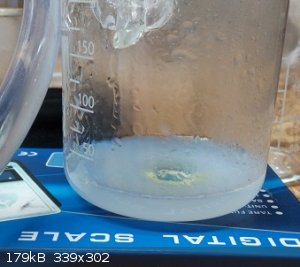
This yellowish layer is clearly seen -
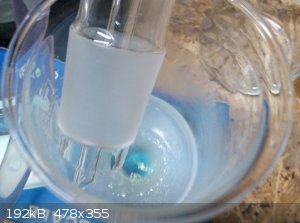
Complete nothing clogs a whole condenser during a distillation process all the way -
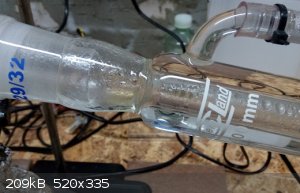
During the distillation a milky forerun becomes more transparent, even enough of water is present in a distilling flask to transfer this milky
component through a condenser. It indicates that this part of liquid being distilled is coming over and almost all of this part is now spent.
After a steam distillation is completed, a yellowish colored layers is isolated by a separation funnel and measured for weight and density.
Total weight is about 21,76g. Weight of 10 ml of it is exactly 10,83g.
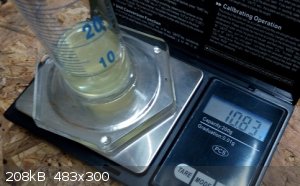
Treat it against solid KOH -
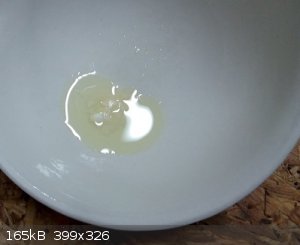
Now treat an initial crude NT mix, free from toluene, against solid KOH
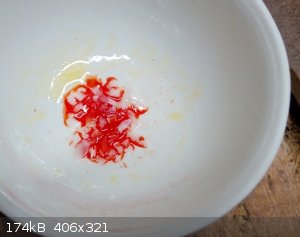
Treating a milky component against solid KOH gave nothing completely, KOH simply dissolves in this.
As conclusion, I would say that although no gained chemicals were 100% identified, it seems that no selective reduction occurs, but a whole reduction
was processed.
A milky stuff is likely an o-toluidine, and yellowish one layer probably is p-toluidine, maybe contaminated with some o-nitrotoluene. Unfortunately I
don't know are toluidines miscible with each other or not, nor as well are nitrotoluenes miscible with toluidines or not.
|
|
|
|